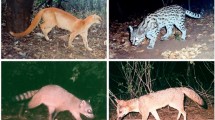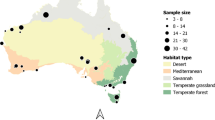Abstract
The feral domestic cat (Felis catus) is considered to be one of the most damaging introduced predators, responsible for the decline and extinction of numerous native species. Advanced satellite technologies enable the study of resource selection by small mammals at fine-scales through remote data. These tools can improve understanding of the spatial ecology of introduced predators in ecologically sensitive areas, such as where cats pose a threat to native species and where improvement of predator control methods is required. We studied fine-scale resource selection by feral cats in the ecologically important New Zealand braided-river ecosystem, where they pose a risk to endangered native ground-nesting birds. We collected 34 location datasets from 21 cats fitted with lightweight global positioning system-collars, and extracted landscape variables from a resource map created using very high spatial resolution satellite imagery (Quickbird) and object-base imagery analysis for image classification. We modelled second-order seasonal and annual resource selection functions and characterized landscape composition of highly-used areas using compositional analysis. At a population level, cats generally selected fine-scale landscapes that are important for their primary prey rabbits (Oryctolagus cuniculus), and for refugia. An external validation of the annual model using data from cats tracked in an independent study showed a positive correlation with model predictions. Individual cats also visited habitats used by native ground-nesting birds, and thus pose a threat to them through secondary predation or individual specialization. Cat control operations should therefore focus around areas of concentrated ground-nesting bird activity and in areas identified as high-use by cats.


Similar content being viewed by others
References
Aebischer NJ, Robertson PA, Kenward RE (1993) Compositional analysis of habitat use from animal radio-tracking data. Ecology 74:1313–1325
Araujo MS, Bolnick DI, Layman CA (2011) The ecological causes of individual specialization. Ecol Lett 14:948–958
Benz UC, Hofmann P, Willhauck G, Lingenfelder I, Heynen M (2004) Multi-resolution, object-oriented fuzzy analysis of remote sensing data for GIS-ready information. ISPRS J Photogramm 58:239–258
Berkeley EP (1982) Maverick cats: encounters with feral cats. Walker, New York
Bjørneraas K, van Moorter B, Rolandsen CM, Herfindal I (2010) Screening Global Positioning System location data for errors using animal movement characteristics. J Wild Manag 74:1361–1366
Blackburn TM, Cassey P, Duncan RP, Evans KL, Gaston KJ (2004) Avian extinction and mammalian introductions on oceanic islands. Science 305:1955–1958
Bonnaud E, Medina FM, Vidal E, Nogales M, Tershy B, Zavaleta E, Donlan C, Keitt B, Le Corre M, Horwath SV (2010) The diet of feral cats on islands: a review and a call for more studies. Biol Invasions 13:581–603
Boyce MS, Vernier PR, Nielsen SE, Schmiegelow FKA (2002) Evaluating resource selection functions. Ecol Model 157:281–300
Bradshaw JWS (1992) The behaviour of the domestic cat. C.A.B. International, Wallingford, UK
Buller WL (1905) Supplement to the birds of New Zealand, vol 2. Buller, London
Burnham KP, Anderson DR (2002) Model selection and multimodel inference, 2nd edn. Springer, New York
Cameron BG, van Heezik Y, Maloney RF, Seddon PJ, Harraway JA (2005) Improving predator capture rates: analysis of river margin trap site data in the Waitaki Basin, New Zealand. New Zeal J Ecol 29:117–128
Congalton R (1991) A review of assessing the accuracy of classifications of remotely sensed data. Remote Sens Environ 37:35–46
Courchamp F, Chapuis JL, Pascal M (2003) Mammal invaders on islands: impact, control and control impact. Biol Rev 78:347–383
Definiens (2010) eCognition Developer 8.0.1—user guide, 1.2.1 ed. Definiens AG, Munich
Duckworth JA, Byrom AE, Fisher P, Horn C (2006) Pest control: does the answer lie in new biotechnologies? In: Allen RB, Lee WG (eds) Biological invasions in New Zealand. Springer, Berlin, pp 422–434
Estes LD, Reillo PR, Mwangi AG, Okin GS, Shugart HH (2010) Remote sensing of structural complexity indices for habitat and species distribution modeling. Remote Sens Environ 114:792–804
Fernandez N (2005) Spatial patterns in European rabbit abundance after a population collapse. Landscape Ecol 20:897–910
Fitzgerald BM, Karl BJ (1988) The diet of domestic cats and their impact on preypupulations. In: Turner D, Bateson P (eds) The domestic cat: the biology of its behaviour. Cambridge University Press, Cambridge
Flux JEC (1965) Timing of the breeding season in the hare, Lepus europaeus Pallas, and rabbit, Oryctolagus cuniculus (L.). Mammalia 29:557–562
Fretwell TJ, LaRue MA, Paul Morin P, Kooyman GL, Wienecke B, Ratcliffe N, Fox AJ, Fleming AH, Porter C, Trathan PN (2012) An emperor penguin population estimate: the first global, synoptic survey of a species from space. PLoS ONE 7(4):e33751
Getz WM, Fortmann-Roe S, Cross PC, Lyons LJ, Ryan SJ, Wilmers CC (2007) LoCoH: nonparameteric kernel methods for constructing home ranges and utilization distributions. PLoS ONE 2(2):e207
Gillies C (2001) Advances in New Zealand mammalogy 1990–2000: house cat. J Roy Soc New Zeal 31:205–218
Gillies C, Fitzgerald BM (2005) The feral cat. In: King CM (ed) The handbook of New Zealand mammals. Oxford University Press, Melbourne, pp 294–307
Gillies CS, Hebblewhite M, Nielsen SE, Krawchuk MA, Aldridge CL, Frair JL, Saher DJ, Stevens CE, Jerde CL (2006) Application of random effects to the study of resource selection by animals. J Anim Ecol 75:887–898
Heather B, Robertson H (2005) The field guide to the birds of New Zealand. Penguin Group, London
Hebblewhite M, Haydon DT (2010) Distinguishing technology from biology: a critical review of the use of GPS telemetry data in ecology. Philos Trans R Soc B 365:2303–2312
Hirzel AH, Le Lay G, Helfer V, Randin C, Guisan A (2006) Evaluating the ability of habitat suitability models to predict species presences. Ecol Model 199:142–152
Hosmer DW, Lemeshow S (2000) Applied logistic regression. Wiley, New York
Howlin S, Erickson WP, Nielson RM (2004). A validation technique for assessing predictive abilities of resource selection functions. In: Western Ecosystem Technologies, Inc. (ed) Proceedings of the first international conference on resource selection laramie, Wyoming, January 13–15, 2003. Resource Selection Methods and Applications. Western, EcoSystems Technology, Inc., Cheyenne, Wyoming, pp 40–51
Hurford A (2009) GPS measurement error gives rise to spurious 180° turning angles and strong directional biases in animal movement data. PLoS ONE 4:e5632
Ims RA (1995) Movement patterns related to spatial structures. In: Hansson L, Fahrig L, Merriam G (eds) Mosaic landscapes and ecological processes. Chapman and Hall, London, pp 85–109
IUCN (2013) IUCN red list of threatened species. Version 2013.1. www.iucnredlist.org. Accessed 24 Sept 2013
Johnson D (1980) The comparison of usage and availability measurements for evaluating resource preference. Ecology 61:65–71
Johnson CJ, Seip DR, Boyce MS (2004) A quantitative approach to conservation planning: using resource selection functions to map the distribution of mountain caribou at multiple spatial scales. J Appl Ecol 41:238–251
King CM (2005) Editor’s introduction. In: King CM (ed) The handbook of New Zealand mammals. Oxford University Press, Melbourne, pp 1–25
Lowe SJ, Browne M, Boudjelas S (2000) 100 of the world’s worst invasive alien species. IUCN/SSC Invasive Species Specialist Group (ISSG), Auckland
Manly BFJ, McDonald LL, Thomas DL, McDonald TL, Erickson WP (2002) Resource selection by animals: statistical design and analysis for field studies, 2nd edn. Kluwer Academic Publishers, Dordrecht
McGarigal K, Marks BJ (1995) FRAGSTATS: spatial pattern analysis program for quantifying landscape structure. Gen Tech Rep PNW-GTR-351, U.S. Department of Agriculture, Forest Service, Pacific Northwest Research Station, Portland, OR
McGlone MS (2006) Becoming New Zealanders: immigration and the formation of the biota. In: Allen RB, Lee WG (eds) Biological invasions in New Zealand. Springer, Berlin, pp 17–33
Norbury G, Reddiex B (2005) European rabbit. In: King C (ed) The handbook of New Zealand mammals. Oxford University Press, Melbourne, pp 131–158
Norbury GL, Norbury DC, Heyward RP (1998) Space use and denning behaviour of wild ferrets (Mustela furo) and cats (Felis catus). New Zeal J Ecol 22:149–159
R Development Core Team (2008) R: a language and environment for statistical computing. R Foundation for Statistical Computing, Vienna
Recio MR, Seddon PJ (2013) Understanding determinants of home range behaviour of feral cats as introduced apex predator in insular ecosystems: a spatial approach. Behav Ecol Sociobiol. doi:10.1007/s00265-013-1605-7
Recio MR, Mathieu R, Maloney R, Seddon PJ (2010) First results of feral cats (Felis catus) monitored with GPS collars in New Zealand. New Zeal J Ecol 34:288–296
Recio MR, Mathieu R, Denys P, Sirguey P, Seddon PJ (2011a) Lightweight GPS-tags, one giant leap for wildlife tracking? An assessment approach. PLoS ONE 6(12):e28225
Recio MR, Mathieu R, Seddon PJ (2011b) Design of a GPS backpack to track European hedgehogs Erinaceus europaeus. Eur J Wildl Res 57:1175–1178
Recio MR, Mathieu R, Hall GB, Moore AB, Seddon PJ (2013a) Landscape resource mapping for wildlife research using very high resolution satellite imagery. Methods Ecol Evol. doi:10.1111/2041-210X.12094
Recio MR, Mathieu R, Latham MC, Latham ADM, Seddon PJ (2013b) Quantifying fine-scale resource selection by introduced European hedgehogs (Erinaceus europaeus) in ecologically sensitive areas. Biol Invasions 15:1807–1818
Rettie WJ, McLoughlin PD (1999) Overcoming radiotelemetry bias in habitat-selection studies. Can J Zool 77:1175–1184
Richter R (1998) Correction of satellite imagery over mountainous terrain. Appl Optics 37:4004–4015
Sanders MD, Maloney RF (2002) Causes of mortality at nests of ground-nesting birds in the Upper Waitaki Basin, South Island, New Zealand: a 5-year video study. Biol Conserv 106:225–236
Sinclair ARE, Pech RP (1996) Density dependence, stochasticity, compensation and predator regulation. Oikos 75:164–173
Smith PG (2003) Compositional analysis Excel tool user’s guide. Version 5.0. 1, Bettws Cottage, Bettws, Abergavenny, NP7 7LG, UK
Tapia L, Domínguez J, Rodríguez L (2010) Modelling habitat use by Iberian hare Lepus granatensis and European wild rabbit Oryctolagus cuniculus in a mountainous area in northwestern Spain. Acta Theriol 55:73–79
Toutin T (2004) Geometric processing of remote sensing images: models, algorithms and methods. Int J Remote Sens 25:1893–1924
Urban D (2005) Modeling ecological processes across scales. Ecology 86:1996–2006
Virgós E, Cabezas-Diaz S, Malo A, Lozano J, Lopez-Huertas D (2003) Factors shaping European rabbit abundance in continuous and fragmented populations of central Spain. Acta Theriol 48:113–122
White GC, Bennetts RE (1996) Analysis of frequency count data using the negative binomial distribution. Ecology 77:2549–2557
Wiens TS, Dale BC, Boyce MS, Kershaw GP (2008) Three way k-fold cross-validation of resource selection functions. Ecol Model 212:244–255
Acknowledgments
We thank Richard Maloney and the Department of Conservation Twizel for logistic support. The ranger Simon Stevenson. To the Godley Peaks and Lylibank Station for access permission to their lands. To David and Cecilia Latham for valuable comments on this article. Trevor Wiens for model validation assistance. To two anonymous reviewers for their valuable comments. This project was conducted under University of Otago Animal Ethics Approval 14/08, funded by a Department of Zoology Research Grant (PJS), and School of Surveying Research Funds (PBRF). Mariano R. Recio was funded by a University of Otago Ph.D. scholarship and by MSI Grant UOOX09043 to PS.
Author information
Authors and Affiliations
Corresponding author
Rights and permissions
About this article
Cite this article
Recio, M.R., Mathieu, R., Virgós, E. et al. Quantifying fine-scale resource selection by introduced feral cats to complement management decision-making in ecologically sensitive areas. Biol Invasions 16, 1915–1927 (2014). https://doi.org/10.1007/s10530-013-0635-4
Received:
Accepted:
Published:
Issue Date:
DOI: https://doi.org/10.1007/s10530-013-0635-4




